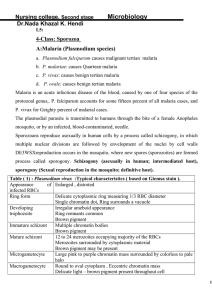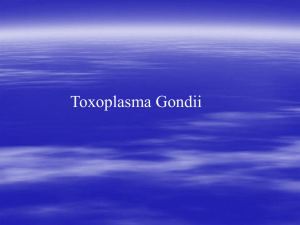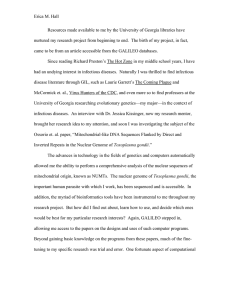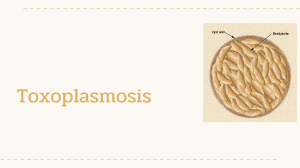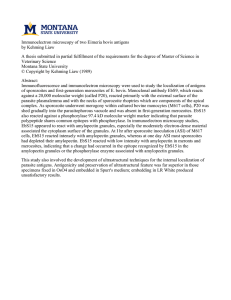Microbiology Nursing college, Dr.Nada Khazal K. Hindi
advertisement
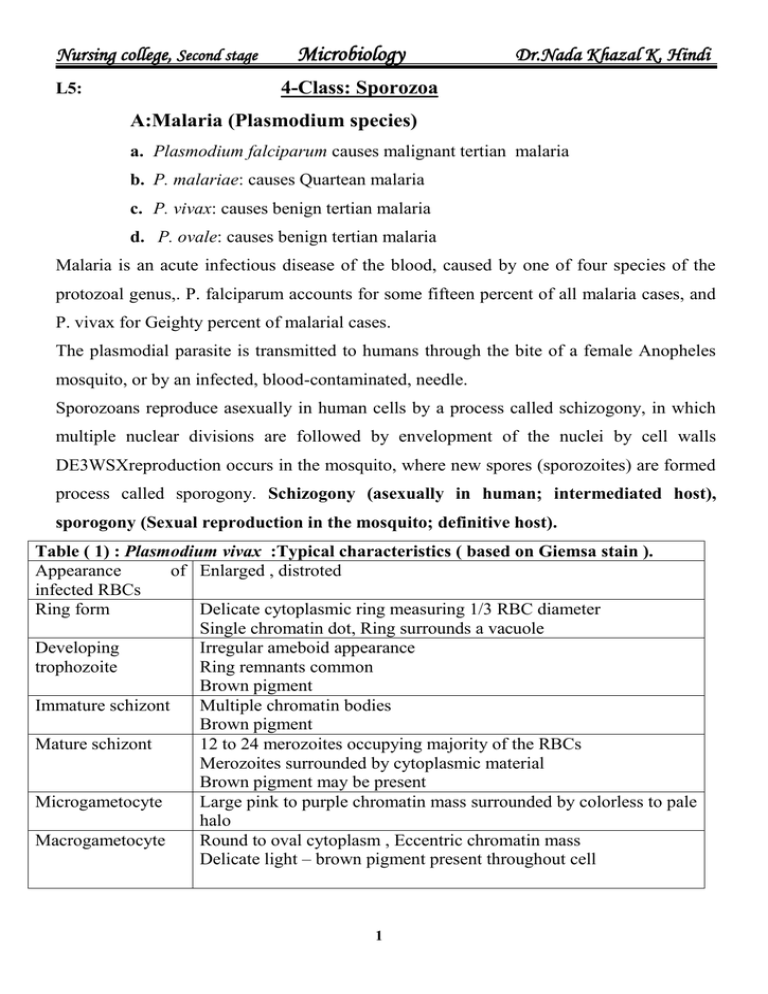
Nursing college, Second stage L5: Microbiology Dr.Nada Khazal K. Hindi 4-Class: Sporozoa A:Malaria (Plasmodium species) a. Plasmodium falciparum causes malignant tertian malaria b. P. malariae: causes Quartean malaria c. P. vivax: causes benign tertian malaria d. P. ovale: causes benign tertian malaria Malaria is an acute infectious disease of the blood, caused by one of four species of the protozoal genus,. P. falciparum accounts for some fifteen percent of all malaria cases, and P. vivax for Geighty percent of malarial cases. The plasmodial parasite is transmitted to humans through the bite of a female Anopheles mosquito, or by an infected, blood-contaminated, needle. Sporozoans reproduce asexually in human cells by a process called schizogony, in which multiple nuclear divisions are followed by envelopment of the nuclei by cell walls DE3WSXreproduction occurs in the mosquito, where new spores (sporozoites) are formed process called sporogony. Schizogony (asexually in human; intermediated host), sporogony (Sexual reproduction in the mosquito; definitive host). Table ( 1) : Plasmodium vivax :Typical characteristics ( based on Giemsa stain ). Appearance of Enlarged , distroted infected RBCs Ring form Delicate cytoplasmic ring measuring 1/3 RBC diameter Single chromatin dot, Ring surrounds a vacuole Developing Irregular ameboid appearance trophozoite Ring remnants common Brown pigment Immature schizont Multiple chromatin bodies Brown pigment Mature schizont 12 to 24 merozoites occupying majority of the RBCs Merozoites surrounded by cytoplasmic material Brown pigment may be present Microgametocyte Large pink to purple chromatin mass surrounded by colorless to pale halo Macrogametocyte Round to oval cytoplasm , Eccentric chromatin mass Delicate light – brown pigment present throughout cell 1 Nursing college, Second stage Microbiology Dr.Nada Khazal K. Hindi Pathology and clinical significance: Plasmodium sporozoites are injected into the bloodstream, where they rapidly migrate to the liver. There they form cyst-like structures containing thousands of merozoites. Upon release, the merozoites invade red blood cells, using hemoglobin as a nutrient. Eventually, the infected red cells rupture, releasing merozoites that can invade other erythrocytes. If large numbers of red cells rupture at roughly the same time, a paroxysm (sudden onset) of fever can result from the massive release of toxic substances. Plasmodium falciparum is the most dangerous plasmodial species. It can cause a rapidly fulminating disease, characterized by persistent high fever and orthostatic hypotension. Infection can lead to capillary obstruction and death if treatment is not prompt. P. malariae, P. vivax, and P. ovale cause milder forms of the disease, probably because they invade either young or old red cells, but not both. This is in contrast to P. falciparum, which invades cells of all ages. Even today, malarial infection is a common and serious disease, causing some 300 million cases per year, with a death rate of about one percent. Clinical symptoms Benign Tertian Malaria. Patients infected with P. vivax typically begin to develop symptoms following a 10 to 17 day incubation period following exposure. These vague symptoms mimic those usually seen in cases of the flu, including nausea, vomiting, headache, muscle pains, and photophobia . As infected RBCs begin to rupture, the resulting merozoites, hemoglobin, and toxic cellular was products initiate the first in a series of paroxysms. These paroxysms typically occur every 48 hours. Life cycle Members of the mosquito genus Anopheles are responsible for the tranismission of malaria to humans via a blood meal. These vector transfers malarial sporozoites form its salivary gland into the human wound. Following entrance into the body, the sporozoites are carried 2 Nursing college, Second stage Microbiology Dr.Nada Khazal K. Hindi through the preipheral blood to the parenchymal cells of the liver. It is here where schizogony occurs. This exoerythrocytic cycle of growth and reproduction lasts from 8 to 25 days, depending on the specific Plasmodium species involved. The infected liver cells eventually rupture and introduce merozoites into the circulating blood. These migrating merozoites target age and – size – specific RBCs to invade, and upon doing so initiate the erythrocytic cycle of growth .it is in this asexual phase that the plasmodia feed on hemoglobin and pass through the numerous stages of growth, including the six morphologic forms previosly described. Upon formation of the merozoites, one of three paths may take place. Some of the RBCs infected with merozoites rupture, releasing these forms to target and infect new RBCs, and this part of the cycle repeats itself. Numerous erythrocytic cycles may occur. However, other infected RBCs containing merozoites develop into microgametocytes and macrogametocytes. Still others are destroyed by the immune system of otherwise healthy individual. Transmission of malaria back into the vector occur when the mosquito ingests mature male (micro) and female (macro) gametocytes during a blood meal, thus initiating the sexual cycle of growth. a male and female gametocyte unite in the mosquito’s stomach and form a zygote matures into an oocyst . upon complete maturation , the oocyst ruptures and releases numerous sporozoites , which migrate into salivary gland of the mosquito and are ready to infect another unsuspecting human . Thus the cycle repeats itself. Drug treatment depends on the stage of infection. Primaquine is effective against the exoerythrocytic forms in the liver and bloodstream and also against the gametocytic form, but inactive against parasites in red blood cells. Therefore, for the erythrocytic form, primaquine is administered in conjunction with a blood schizontocide such as chloroquine, 3 Nursing college, Second stage Microbiology Dr.Nada Khazal K. Hindi Fig. (1) : Plasmodium vivax life cycle . B: Toxoplasmosis (Toxoplasma gondii) Toxoplasma gondii is a sporozoan, distributed worldwide, that infects all vertebrate species, although the definitive host is the cat. Humans can become infected by the accidental ingestion of oocysts present in cat feces, by eating raw or undercooked meat, congenitally from an infected mother, or from a blood transfusion. Table ( 2 ): Toxoplasma gondii oocyst : Typical characteristics Size range 25 to 35 μm long , 10 to 15 μm wide Appearance Transparent Shape Oval Other features Young oocyst contains two sporoblasts. Mature oocyst contains two sporocysts, each containing four sporozoites. Table ( 3 ): Toxoplasma gondii tachyzoite : Typical characteristics General comment Actively multiplying morphologic form Size 3 to 7 μm by 2 to 4 μm Shape Crescent shaped , often more rounded one end Number of nucleui One Other features Contains a variety of organelles that are not readily visible 4 Nursing college, Second stage Microbiology Dr.Nada Khazal K. Hindi Table ( 4 ): Toxoplasma gondii Bradyzoite : Typical characteristics General comment Slow - growing morphologic form Size Smaller than tachyzoites Physical appearance Similar to that of the tachyzoites Number of nucleui One Other features Hundreds to thousands of bradyzoites enclose themselves to form a cyst that may measure 12 to 100 μm in diameter Pathology and clinical significance: There are two kinds of Toxoplasma trophozoites found in human infections: rapidly growing tachyzoites (tachy = rapid) that are seen in body fluids in early, acute infections, and slowly growing bradyzoites (brady = slow) that are contained in cysts in muscle and brain tissue and in the eye. Tachyzoites directly destroy cells, particularly parenchymal and reticuloendothelial cells, whereas bradyzoites released from ruptured tissue cysts cause local inflammation with blockage of blood vessels and necrosis. Infections of normal human hosts are common and usually asymptomatic. However, they can be very severe in immunocompromised individuals, who may also suffer recrudescence (relapse) of the infection. Congenital infections can also be severe, resulting in stillbirths, brain lesions, and hydrocephaly and they are a major cause of blindness in newborns. Life cycle The definitive host in the Toxoplasma life cycle is the cat (or other felines). Upon ingestion of Toxoplasma cysts present in the brain or muscle tissue of contaminated mice or rats, the enclosed bradyzoites are released in the cat and quickly transform into tachyzoites. Both sexual and asexual reproduction occurs in the gut of the cat. The sexual cycle results in the production of immature oocysts, which are ultimately shed in the stool. The oocysts complete their maturation in the outside environment, a process that typically takes from 1 to 5 days. Rodents, particularly mice and rats, serve as the intermediate hosts, ingesting the infected mature Toxoplasma oocysts while foraging for food. The sporozoites emerge from the mature oocyst and rapidly convert into actively growing tachyzoites in the intestinal epithelium of the rodent. Clinical symptoms Toxoplasmosis a common infection with the protozoan intracellular parasite Toxoplasma gondii. It is marked in its inborn form by liver and brain involvement with calcium in the 5 Nursing college, Second stage Microbiology Dr.Nada Khazal K. Hindi brain (cerebral calcification), convulsions, blindness, too-small head and fluid on the brain (microcephaly and hydrocephaly), and mental retardation. The acquired form is marked by rash, disease of the lymph nodes (lymphadenopathy), fever, malaise, central nervous system disorders, swelling of the heart wall (myocarditis), and swelling of lung tissue (pneumonitis). Cats acquire the organism by eating infected birds and mice. Lumps (cysts) of the organism are carried from cat feces to humans or by human ingestion of inadequately cooked meat containing the lumps. Infection through the placenta occurs only during acute infection of the mother. The other route of human infection occurs when contaminated blood is transfused into an uninfected person. Diagnosis and treatment: The initial diagnostic approach involves detection of parasites in tissue specimens, but this may often be inconclusive. With the recent availability of commercial diagnostic kits, serologic tests to identify toxoplasma are now routinely used. These include tests for Toxoplasma-specific IgG and IgM. The treatment of choice for this infection is the antifolate drug pyrimethamine, given in combination with sulfadiazine. 6
